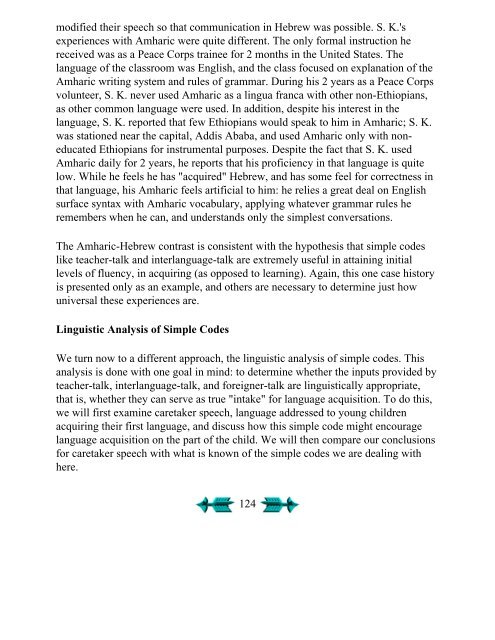Second Language Acquisition and Second ... - Stephen Krashen
Second Language Acquisition and Second ... - Stephen Krashen
Second Language Acquisition and Second ... - Stephen Krashen
Create successful ePaper yourself
Turn your PDF publications into a flip-book with our unique Google optimized e-Paper software.
modified their speech so that communication in Hebrew was possible. S. K.'s<br />
experiences with Amharic were quite different. The only formal instruction he<br />
received was as a Peace Corps trainee for 2 months in the United States. The<br />
language of the classroom was English, <strong>and</strong> the class focused on explanation of the<br />
Amharic writing system <strong>and</strong> rules of grammar. During his 2 years as a Peace Corps<br />
volunteer, S. K. never used Amharic as a lingua franca with other non-Ethiopians,<br />
as other common language were used. In addition, despite his interest in the<br />
language, S. K. reported that few Ethiopians would speak to him in Amharic; S. K.<br />
was stationed near the capital, Addis Ababa, <strong>and</strong> used Amharic only with noneducated<br />
Ethiopians for instrumental purposes. Despite the fact that S. K. used<br />
Amharic daily for 2 years, he reports that his proficiency in that language is quite<br />
low. While he feels he has "acquired" Hebrew, <strong>and</strong> has some feel for correctness in<br />
that language, his Amharic feels artificial to him: he relies a great deal on English<br />
surface syntax with Amharic vocabulary, applying whatever grammar rules he<br />
remembers when he can, <strong>and</strong> underst<strong>and</strong>s only the simplest conversations.<br />
The Amharic-Hebrew contrast is consistent with the hypothesis that simple codes<br />
like teacher-talk <strong>and</strong> interlanguage-talk are extremely useful in attaining initial<br />
levels of fluency, in acquiring (as opposed to learning). Again, this one case history<br />
is presented only as an example, <strong>and</strong> others are necessary to determine just how<br />
universal these experiences are.<br />
Linguistic Analysis of Simple Codes<br />
We turn now to a different approach, the linguistic analysis of simple codes. This<br />
analysis is done with one goal in mind: to determine whether the inputs provided by<br />
teacher-talk, interlanguage-talk, <strong>and</strong> foreigner-talk are linguistically appropriate,<br />
that is, whether they can serve as true "intake" for language acquisition. To do this,<br />
we will first examine caretaker speech, language addressed to young children<br />
acquiring their first language, <strong>and</strong> discuss how this simple code might encourage<br />
language acquisition on the part of the child. We will then compare our conclusions<br />
for caretaker speech with what is known of the simple codes we are dealing with<br />
here.<br />
124











